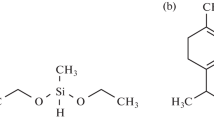Abstract
The TRIDYN collisional computer simulation has been modified to account for emission of ionic species and molecules during sputter depth profiling, by introducing a power law dependence of the ion yield as a function of the oxygen surface concentration and by modelling the sputtering of monoxide molecules. The results are compared to experimental data obtained with dual beam TOF–SIMS depth profiling of ZrO2/SiO2/Si high-k dielectric stacks with thicknesses of the SiO2 interlayer of 0.5, 1, and 1.5 nm. Reasonable agreement between the experiment and the computer simulation is obtained for most of the experimental features, demonstrating the effects of ion-induced atomic relocation, i.e., atomic mixing and recoil implantation, and preferential sputtering. The depth scale of the obtained profiles is significantly distorted by recoil implantation and the depth-dependent ionization factor. A pronounced double-peak structure in the experimental profiles related to Zr is not explained by the computer simulation, and is attributed to ion-induced bond breaking and diffusion, followed by a decoration of the interfaces by either mobile Zr or O.
Similar content being viewed by others
References
H. De Witte: Ph.D. Thesis, University of Antwerp, Belgium (2001)
H. De Witte, T. Conard, W. Vandervorst, R. Gijbels: Appl. Surf. Sci. 203–204, 523 (2003)
T. Conard, W. Vandervorst, J. Petry, C. Zhao, W. Besling, H. Nohira, O. Richard: Appl. Surf. Sci. 203–204, 400 (2003)
J. Bellingham, M.G. Dowsett, E. Collart, D. Kirkwood: Appl. Surf. Sci. 203–204, 851 (2003)
Y. Yamamoto, Y. Hayashi, Y. Tachibana, N. Shimodara, M. Kudo: Appl. Surf. Sci. 203–204, 863 (2003)
M.A. Karolevski, R.G. Cavell: Appl. Surf. Sci. 193, 11 (2002)
M. Parego, S. Ferrari, S. Spiga, M. Fanciulli: Appl. Surf. Sci. 203–204, 110 (2003)
S. Hayashi, K. Yanagihara: Appl. Surf. Sci. 203–204, 339 (2003)
M. Parego, S. Ferrari, S. Spiga, E. Bonera, M. Fanciulli, V. Soncini: Appl. Phys. Lett. 82, 121 (2002)
T. Janssens: Impact of the oxygen concentration on the quantification of secondary ion mass spectrometry profiles in Si. Ph.D. Thesis, Katholieke Universiteit Leuven (2002)
T. Janssens, F. Huyghebaerth, W. Vandervorst, A. Gildenpfennig, H.H. Brongersma: Appl. Surf. Sci. 203–204, 30 (2003)
R. Smith, M. Jakas, D. Ashworth, B. Oven, M. Bowyer, I. Chakarov, R. Webb: Atomic and Ion Collisions in Solids and at Surfaces – Theory, Simulation and Applications ,Cambridge University Press. Cambridge (1997)
V. Ignatova, I. Katardjiev, I. Chakarov, D. Karpuzov: Computer simulations of ion-solid interactions for materials characterization, in preparation
W. Eckstein: Computer Simulation of Ion-Solid Interactions, Springer, Heidelberg/Berlin (1991)
W. Möller: “Computer simulation of stopping and sputtering”, in: Materials Modification by HighFluence Ion Beams, R. Kelly and M. Fernanda da Silva, NATO ASI Series E, Vol. 155, Kluwer Academic Publ., Dordrecht/Boston/London (1989)
W. Möller, W. Eckstein: Nucl. Instr. Meth. B 2, 814 (1984)
W. Möller, W. Eckstein, J.P. Biersack: Comp. Phys. Comm. 51, 355 (1988)
B. Baretzky, W. Möller, E. Taglauer: Vacuum 43, 1207 (1992)
B. Baretzky, W. Möller, E. Taglauer: Nucl. Instr. Methods B 18, 496 (1987)
W. Möller, B. Baretzky: “Computer simulation of atomic collisions in multicomponent media”, in: The Physics of Ionized Gases, L. Tanovic, N. Konjevic, N. Tanevic: Nova Science Publ., New York (1989)
V.A. Ignatova, T. Conard, W. Möller, W. Vandervorst, R. Gijbels: Appl. Surf. Sci. 231–232, 603 (2004)
J.P. Biersack, L.G. Haggmark: Nucl. Instr. Methods 174, 257 (1980)
J.F. Ziegler, J.P. Biersack, U. Littmark: Stopping Power and Ranges of Ions in Matter, Vol. 1, ed. by J.F. Ziegler (Pergamon Press, New York 1985).
J.F. Ziegler: Freeware Package “Stopping and Ranges of Ions in Matter (SRIM 2000)”, http://www.srim.org
W. Eckstein, J.P. Biersack: Appl. Phys. A 37, 95 (1985)
W. Möller, D. Bouchier, O. Burat, V. Stambouli: Surf. Coat. Technol. 45, 73 (1991)
W. Möller: Thin Sol. Films, 228, 319 (1993)
W.D. Wilson, L.G. Haggmark, J.P. Biersack: Phys. Rev. B 15, 2458 (1977)
J. Lindhard, M. Scharff: Phys. Rev. 124, 128 (1961)
O.S. Oen, M.T. Robinson: Nucl. Instr. Methods 132, 647 (1976)
W. Möller, M. Posselt: “TRIDYN-FZR User Manual”, Institute of Ion Beam Physics and Materials Research, Forschungzentrum Rossendorf, Report FZR-317 (2001)
H. Oechsner: “Molecule formation in oxide sputtering”, p.106, in: Springer Series in Chemical Physics 19 “Secondary Ion Mass Spectrometry SIMS III”, ed. by A.Benninghoven, J. Giber, J. László, M. Riedel, H. W. Werner, Springer (1982)
J. Vlekken, T.-D Wu, M. Olieslaeger, G. Knyut, W. Vandervorst, L. De Schepper: In Proc. of Secondary Ion Mass Spectrometry, SIMS XI, 895 (1998)
K.J. Snowdon, R.A. Haring: Nucl. Instrum. Methods B 18, 596 (1987)
V. Ignatova, I. Chakarov, A. Torrisi, A. Licciardello: Appl. Surf. Science 187, 145 (2002)
H. De Witte, T. Conard, W. Vandervorst, R. Gijbels: Appl. Surf. Sci. 203–204, 523 (2003)
W. Vandervorst, J. Bennett, C. Huyghebart, T. Conard, C. Gondran, H. De Witte: Appl. Surf. Sci. 231–232, 569 (2004)
Author information
Authors and Affiliations
Corresponding author
Additional information
PACS
68.49; 79.20; 81.65; 82.80
Rights and permissions
About this article
Cite this article
Ignatova, V., Möller, W., Conard, T. et al. Interpretation of TOF–SIMS depth profiles from ultrashallow high-k dielectric stacks assisted by hybrid collisional computer simulation. Appl. Phys. A 81, 71–77 (2005). https://doi.org/10.1007/s00339-005-3239-8
Received:
Accepted:
Published:
Issue Date:
DOI: https://doi.org/10.1007/s00339-005-3239-8




